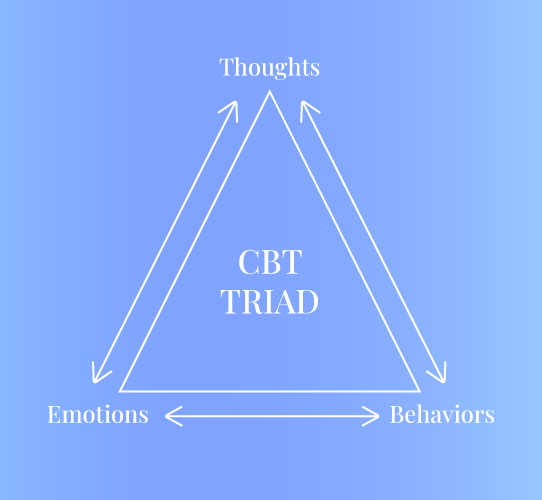Cognitive-behavioral Therapy
Cognitive-behavioral therapy (CBT) refers to a type of evidenced-based psychotherapy that is founded on cognitive and behavioral principles. “Evidence-based” means that the treatments are supported by scientific research and clinical evidence demonstrating their effectiveness. The focus of CBT is on identifying and changing negative thought patterns, emotions and behaviors, which are interconnected; each element affects the other two. CBT developed from behavior therapy (BT), which is based on principles of learning and conditioning and focuses primarily on changing observable behaviors that are adversely affecting a person’s life rather than on changing thoughts.
The Core Principles of CBT

- The CBT triad is a core concept in CBT that highlights the interconnection between thoughts, emotions, and behaviors. Negative thinking patterns can lead to negative emotions and unhelpful behaviors, and changing behavior can impact thoughts and emotions.
- CBT is structured around specific goals tailored to the individual’s issues.
- CBT is typically a short-term treatment, which is structured, with sessions often focusing on one specific problem or skill to learn each time.
- The therapist and client work together to set goals, develop strategies, and evaluate progress. Transparency and collaboration empower clients to play an active role in their treatment.
- CBT teaches practical skills, such as identifying cognitive distortions, problem-solving, relaxation techniques, and coping mechanisms. These skills can be applied outside of therapy and in the long term.
- While past experiences are acknowledged, CBT primarily focuses on current issues and ways to manage present challenges, aiming to provide tools that clients can use in real-life situations
- CBT is highly researched and grounded in scientific evidence. Interventions are continually tested, refined, and shown to be effective for various mental health conditions.
Some of the Components of Cognitive-Behavioral Therapy
- The therapist conducts a thorough assessment to understand the individual’s issues, symptoms, and history.
- They collaborate to set specific, realistic, and measurable goals for therapy.
- The therapist explains the CBT model, especially the cognitive triad (thoughts, feelings, behaviors), to help the individual understand how these three components interact and contribute to their difficulties.
- In CBT, individuals are encouraged to engage in specific behaviors, including tackling avoided situations.
- Therapy may include teaching coping strategies and skills for dealing with challenges that help individuals handle stress more effectively.
- Individuals are asked to monitor and record behaviors they are working on.
- Homework is a key part of CBT, often includes practicing what’s been learned in therapy to real-life situations.
- Toward the end of therapy, the therapist and individual develop a plan to prevent relapse, including ongoing practice of CBT techniques and scheduling follow-up sessions.

Different forms of BT and/or CBT are effective for various problems and each approach has a specific framework and technique set. Often therapists choose or combine approaches, such as these listed, based on an individual’s unique needs.
Exposure and Response Prevention (ERP)
Comprehensive Behavioral Model (ComB)
Comprehensive Behavioral Intervention for Tics (CBIT)

